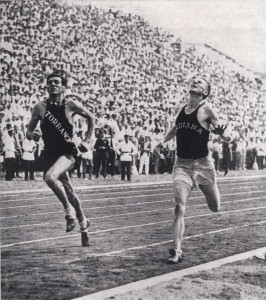Louis Zamperini serves as inspiration
Students walk by Cromwell Field every day, but do most know of the legacy inside?
Just within the front gate is a tribute to USC track star Louis Zamperini.

Ahead of the pack · USC’s track and field team should look to Louis Zamperini for inspiration and Trojan spirit this season. - Photo courtesy of USC Sports Information
With the 2012 track and field season in progress, the rising stars of USC should look toward the story of Zamperini for inspiration.
Deemed a troublemaker in his early childhood, the Torrance, Calif., native found solace through running track.
In 1934, Zamperini set a world interscholastic record for the mile at the state championships with a time of 4:21.2.
One week later, he clinched the championship with a 4:27.8 mile. It wasn’t long before USC him for the team.
Zamperini earned a spot on the 1936 Olympic team, running the 5,000-meter event.
He placed eighth in the race held in Berlin, catching the eye of Adolf Hitler. The dictator was so taken with Zamperini’s performance that he demanded to meet the track star.
After an iconic trip to the 1936 Olympic Games, Zamperini set his sights on the 1940 games in Tokyo. In 1938, he represented USC at the NCAA championships. Dealing with gruesome injuries (cracked ribs, sliced shins and bleeding toes), Zamperini set a NCAA record with 4:08.3 mile. He was close to breaking the four-minute mile, but something much bigger dashed those aspirations.
At the height of World War II, Zamperini enlisted in the United States Army Air Force. Soon after, Zamperini was deployed to Hawaii to serve as a bombardier. He and his crew boarded a B-24 in May 1943 to search for a missing crew. After the first B-24 was massacred with bullets, the crew boarded a second aircraft. Named “The Green Hornet,” the aircraft plummeted into the ocean after enduring mechanical difficulties. The crash killed eight of the 11 men onboard. Zamperini, Russell Philips (pilot), and Francis McNamara (tail-gunner) survived the ordeal.
Back home, Zamperini had been declared dead. But surviving shark attacks and Japanese bomb attempts, the three men floated in the middle of the vast sea for 33 days before McNamara’s passing. Zamperini and Philips reached the Marshall Islands by the 47th day and were eventually captured by the Japanese Navy. Both endured multiple prisoner of war camps before being released.
Celebrating his 95th birthday last month, Zamperini’s story continues to be motivational. Seabiscuit author Lauren Hillenbrand’s 2010 Unbroken serves as a record of the life of a hero from USC.
And Zamperini’s post-war life has become just as honorable as his war exploits. He has become a true source of inspiration through his great acts of charity and compassion.
As Trojans, we should look to Zamperini for inspiration to continue the Trojan spirit and, in his words, “Be Hardy.”
“Armchair Quarterback” runs Tuesdays. To comment on this article, email Andie at [email protected] or visit DailyTrojan.com.
